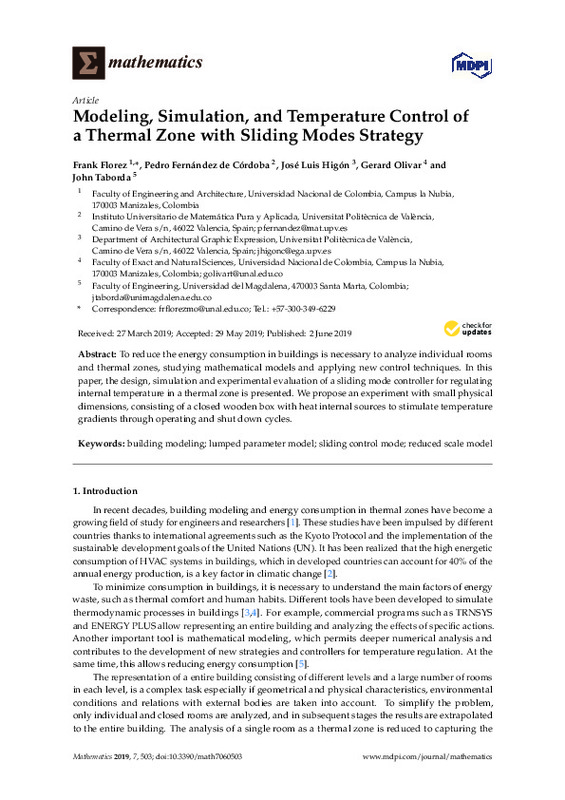Delgarm, N., Sajadi, B., & Delgarm, S. (2016). Multi-objective optimization of building energy performance and indoor thermal comfort: A new method using artificial bee colony (ABC). Energy and Buildings, 131, 42-53. doi:10.1016/j.enbuild.2016.09.003
Gorni, D., Castilla, M. del M., & Visioli, A. (2016). An efficient modelling for temperature control of residential buildings. Building and Environment, 103, 86-98. doi:10.1016/j.buildenv.2016.03.016
Fazenda, P., Lima, P., & Carreira, P. (2016). Context-based thermodynamic modeling of buildings spaces. Energy and Buildings, 124, 164-177. doi:10.1016/j.enbuild.2016.04.068
[+]
Delgarm, N., Sajadi, B., & Delgarm, S. (2016). Multi-objective optimization of building energy performance and indoor thermal comfort: A new method using artificial bee colony (ABC). Energy and Buildings, 131, 42-53. doi:10.1016/j.enbuild.2016.09.003
Gorni, D., Castilla, M. del M., & Visioli, A. (2016). An efficient modelling for temperature control of residential buildings. Building and Environment, 103, 86-98. doi:10.1016/j.buildenv.2016.03.016
Fazenda, P., Lima, P., & Carreira, P. (2016). Context-based thermodynamic modeling of buildings spaces. Energy and Buildings, 124, 164-177. doi:10.1016/j.enbuild.2016.04.068
Bacher, P., & Madsen, H. (2011). Identifying suitable models for the heat dynamics of buildings. Energy and Buildings, 43(7), 1511-1522. doi:10.1016/j.enbuild.2011.02.005
Ryzhov, A., Ouerdane, H., Gryazina, E., Bischi, A., & Turitsyn, K. (2019). Model predictive control of indoor microclimate: Existing building stock comfort improvement. Energy Conversion and Management, 179, 219-228. doi:10.1016/j.enconman.2018.10.046
Fiorentini, M., Wall, J., Ma, Z., Braslavsky, J. H., & Cooper, P. (2017). Hybrid model predictive control of a residential HVAC system with on-site thermal energy generation and storage. Applied Energy, 187, 465-479. doi:10.1016/j.apenergy.2016.11.041
Massa Gray, F., & Schmidt, M. (2016). Thermal building modelling using Gaussian processes. Energy and Buildings, 119, 119-128. doi:10.1016/j.enbuild.2016.02.004
Ascione, F., Bianco, N., De Stasio, C., Mauro, G. M., & Vanoli, G. P. (2016). Simulation-based model predictive control by the multi-objective optimization of building energy performance and thermal comfort. Energy and Buildings, 111, 131-144. doi:10.1016/j.enbuild.2015.11.033
Acosta, A., González, A. I., Zamarreño, J. M., & Álvarez, V. (2016). Energy savings and guaranteed thermal comfort in hotel rooms through nonlinear model predictive controllers. Energy and Buildings, 129, 59-68. doi:10.1016/j.enbuild.2016.07.061
Afram, A., & Janabi-Sharifi, F. (2014). Theory and applications of HVAC control systems – A review of model predictive control (MPC). Building and Environment, 72, 343-355. doi:10.1016/j.buildenv.2013.11.016
Nagarathinam, S., Doddi, H., Vasan, A., Sarangan, V., Venkata Ramakrishna, P., & Sivasubramaniam, A. (2017). Energy efficient thermal comfort in open-plan office buildings. Energy and Buildings, 139, 476-486. doi:10.1016/j.enbuild.2017.01.043
Smarra, F., Jain, A., de Rubeis, T., Ambrosini, D., D’Innocenzo, A., & Mangharam, R. (2018). Data-driven model predictive control using random forests for building energy optimization and climate control. Applied Energy, 226, 1252-1272. doi:10.1016/j.apenergy.2018.02.126
Killian, M., Mayer, B., & Kozek, M. (2016). Cooperative fuzzy model predictive control for heating and cooling of buildings. Energy and Buildings, 112, 130-140. doi:10.1016/j.enbuild.2015.12.017
Brastein, O. M., Perera, D. W. U., Pfeifer, C., & Skeie, N.-O. (2018). Parameter estimation for grey-box models of building thermal behaviour. Energy and Buildings, 169, 58-68. doi:10.1016/j.enbuild.2018.03.057
Lirola, J. M., Castañeda, E., Lauret, B., & Khayet, M. (2017). A review on experimental research using scale models for buildings: Application and methodologies. Energy and Buildings, 142, 72-110. doi:10.1016/j.enbuild.2017.02.060
Coutinho, C. P., Baptista, A. J., & Dias Rodrigues, J. (2016). Reduced scale models based on similitude theory: A review up to 2015. Engineering Structures, 119, 81-94. doi:10.1016/j.engstruct.2016.04.016
Chew, L. W., Glicksman, L. R., & Norford, L. K. (2018). Buoyant flows in street canyons: Comparison of RANS and LES at reduced and full scales. Building and Environment, 146, 77-87. doi:10.1016/j.buildenv.2018.09.026
Chen, S.-Y., & Gong, S.-S. (2017). Speed tracking control of pneumatic motor servo systems using observation-based adaptive dynamic sliding-mode control. Mechanical Systems and Signal Processing, 94, 111-128. doi:10.1016/j.ymssp.2017.02.025
Huang, Y., Khajepour, A., Ding, H., Bagheri, F., & Bahrami, M. (2017). An energy-saving set-point optimizer with a sliding mode controller for automotive air-conditioning/refrigeration systems. Applied Energy, 188, 576-585. doi:10.1016/j.apenergy.2016.12.033
Mironova, A., Mercorelli, P., & Zedler, A. (2016). Robust Control using Sliding Mode Approach for Ice-Clamping Device activated by Thermoelectric Coolers. IFAC-PapersOnLine, 49(25), 470-475. doi:10.1016/j.ifacol.2016.12.067
Norton, M., Khoo, S., Kouzani, A., & Stojcevski, A. (2015). Adaptive fuzzy multi‐surface sliding control of multiple‐input and multiple‐output autonomous flight systems. IET Control Theory & Applications, 9(4), 587-597. doi:10.1049/iet-cta.2014.0209
Fux, S. F., Ashouri, A., Benz, M. J., & Guzzella, L. (2014). EKF based self-adaptive thermal model for a passive house. Energy and Buildings, 68, 811-817. doi:10.1016/j.enbuild.2012.06.016
[-]









